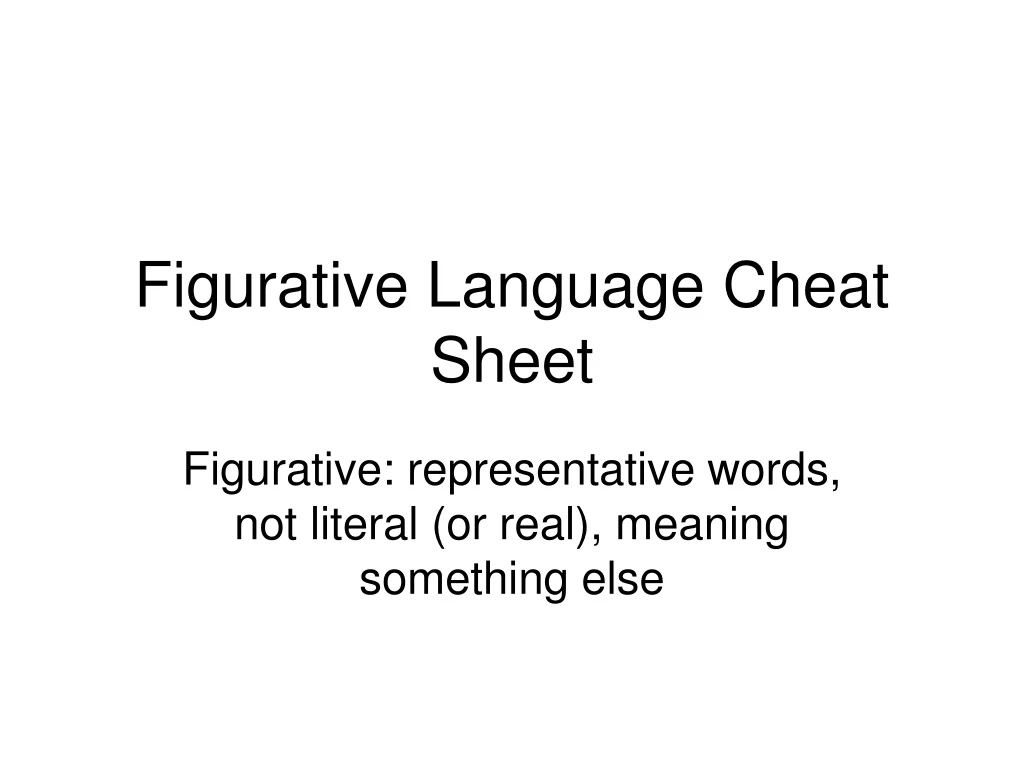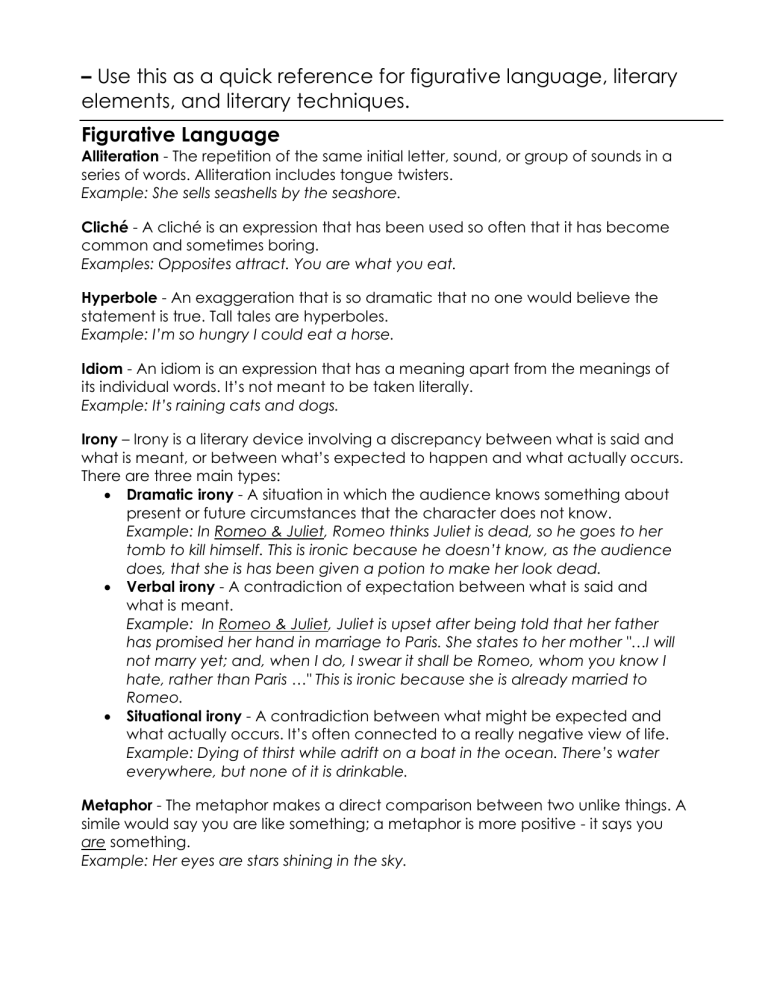Figurative Language Cheat Sheet
Figurative Language Cheat Sheet - Words that sound like what they are. Creating pictures for the senses (through, e.g., similes or metaphors). Web “the bees buzzed.” imagery: Making an inanimate object or animal act like a person puns: “fear was his constant companion.” metaphor: Web figurative language that uses the words “like” or “as” to compare two things. Web (love is a rose.) onomatopoeia: Speech or writing that departs from literal meaning in order to achieve a special effect. Web this view of figurative language focuses on the use of figures of speech that play with the meaning of words, such as metaphor, simile, personification, and hyperbole.
Web (love is a rose.) onomatopoeia: Making an inanimate object or animal act like a person puns: “fear was his constant companion.” metaphor: Creating pictures for the senses (through, e.g., similes or metaphors). Words that sound like what they are. Web figurative language that uses the words “like” or “as” to compare two things. Web “the bees buzzed.” imagery: Speech or writing that departs from literal meaning in order to achieve a special effect. Web this view of figurative language focuses on the use of figures of speech that play with the meaning of words, such as metaphor, simile, personification, and hyperbole.
Web (love is a rose.) onomatopoeia: “fear was his constant companion.” metaphor: Making an inanimate object or animal act like a person puns: Speech or writing that departs from literal meaning in order to achieve a special effect. Creating pictures for the senses (through, e.g., similes or metaphors). Words that sound like what they are. Web this view of figurative language focuses on the use of figures of speech that play with the meaning of words, such as metaphor, simile, personification, and hyperbole. Web “the bees buzzed.” imagery: Web figurative language that uses the words “like” or “as” to compare two things.
The Ultimate Language Arts Cheat Sheets Simple Living. Creative Learning
Creating pictures for the senses (through, e.g., similes or metaphors). Web this view of figurative language focuses on the use of figures of speech that play with the meaning of words, such as metaphor, simile, personification, and hyperbole. Making an inanimate object or animal act like a person puns: Web figurative language that uses the words “like” or “as” to.
PPT Figurative Language Cheat Sheet PowerPoint Presentation, free
Web “the bees buzzed.” imagery: Making an inanimate object or animal act like a person puns: “fear was his constant companion.” metaphor: Web this view of figurative language focuses on the use of figures of speech that play with the meaning of words, such as metaphor, simile, personification, and hyperbole. Web figurative language that uses the words “like” or “as”.
Figurative Language Cheat Sheet Irony Linguistics
“fear was his constant companion.” metaphor: Speech or writing that departs from literal meaning in order to achieve a special effect. Making an inanimate object or animal act like a person puns: Words that sound like what they are. Web “the bees buzzed.” imagery:
figurative language cheat sheet
“fear was his constant companion.” metaphor: Speech or writing that departs from literal meaning in order to achieve a special effect. Words that sound like what they are. Web this view of figurative language focuses on the use of figures of speech that play with the meaning of words, such as metaphor, simile, personification, and hyperbole. Making an inanimate object.
Free Figurative Language Posters Figurative language posters
“fear was his constant companion.” metaphor: Web (love is a rose.) onomatopoeia: Words that sound like what they are. Web “the bees buzzed.” imagery: Making an inanimate object or animal act like a person puns:
1 figurative language cheat sheet
Web (love is a rose.) onomatopoeia: Making an inanimate object or animal act like a person puns: Creating pictures for the senses (through, e.g., similes or metaphors). Web “the bees buzzed.” imagery: Speech or writing that departs from literal meaning in order to achieve a special effect.
FREE Poetry Terms Printable for Middle School and High School
Making an inanimate object or animal act like a person puns: Web “the bees buzzed.” imagery: Creating pictures for the senses (through, e.g., similes or metaphors). Speech or writing that departs from literal meaning in order to achieve a special effect. Words that sound like what they are.
Figurative Language The Secret Weapon Of Masterful Writers Love English
Creating pictures for the senses (through, e.g., similes or metaphors). Web (love is a rose.) onomatopoeia: “fear was his constant companion.” metaphor: Web “the bees buzzed.” imagery: Web figurative language that uses the words “like” or “as” to compare two things.
Figurative Language Imagery Worksheet IMAGECROT
Web this view of figurative language focuses on the use of figures of speech that play with the meaning of words, such as metaphor, simile, personification, and hyperbole. Web “the bees buzzed.” imagery: “fear was his constant companion.” metaphor: Web (love is a rose.) onomatopoeia: Web figurative language that uses the words “like” or “as” to compare two things.
Figurative Language Cheat Sheet Figurative language, Teaching
Web “the bees buzzed.” imagery: Speech or writing that departs from literal meaning in order to achieve a special effect. Words that sound like what they are. Web figurative language that uses the words “like” or “as” to compare two things. Web this view of figurative language focuses on the use of figures of speech that play with the meaning.
Speech Or Writing That Departs From Literal Meaning In Order To Achieve A Special Effect.
Making an inanimate object or animal act like a person puns: Web “the bees buzzed.” imagery: “fear was his constant companion.” metaphor: Creating pictures for the senses (through, e.g., similes or metaphors).
Web Figurative Language That Uses The Words “Like” Or “As” To Compare Two Things.
Words that sound like what they are. Web (love is a rose.) onomatopoeia: Web this view of figurative language focuses on the use of figures of speech that play with the meaning of words, such as metaphor, simile, personification, and hyperbole.









